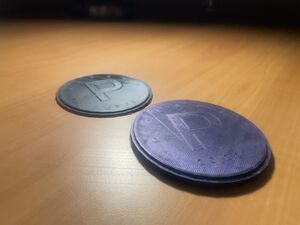
This is a 3D-printed custom coaster designed to showcase school spirit and provide an affordable and personalized solution for protecting surfaces from moisture and stains. The coaster is designed with the Principia school logo and Class of 2023 (or any other class), making it a great gift or keepsake for students, alumni, and faculty.
The design is created using OpenSCAD, an open-source software for creating 3D models, and is an accessible and customizable solution. The coaster can be easily adapted to feature different school logos and class years, making it a versatile solution for a range of school-related events and occasions.
This OSAT project is appropriate because it fulfills the basic need for protecting surfaces and showcasing school pride. It is a low-cost solution that can be produced using open-source 3D printing technology, making it accessible to a wide range of users.
Overall, this 3D printed custom coaster is an improvement on existing designs, incorporating school branding and personalization while addressing common issues such as moisture and stain protection. Its simple and practical design makes it a valuable asset for anyone looking for an affordable and efficient solution for protecting surfaces while showing off their school spirit.
Author & Creator[edit | edit source]
Project developed by Brad Mulwenge
Bill of Materials[edit | edit source]
- Provide a full BOM -- Materials needed for fabrication of device and alternative materials if they are not available, prices/sources of non-printable parts
- Filament (any color of your choice)
- Open source CAD file for coaster design
- 3D printer (Jellybox or similar RepRap)
- Sandpaper (optional)
Tools needed[edit | edit source]
- 3D printer
- Sandpaper (optional).
Skills and knowledge needed[edit | edit source]
To create this 3D printed clip/peg project, you will need basic knowledge of 3D printing and access to a 3D printer. If you are new to 3D printing, you may find these resources helpful:
Technical Specifications and Assembly Instructions[edit | edit source]
- To print the coaster, you will need to download the 3D model file and upload it to your 3D printer software. The file can be customized to any class or even change the logo before printing. The print time estimate is approximately 2 hours, depending on your printer's settings and speed. After printing, you can use sandpaper to smooth out any rough edges or bumps. The coaster is ready to use after printing and sanding.
Common Problems and Solutions[edit | edit source]
- One common issue with 3D printing is that the printed part may not turn out as expected due to printer calibration or other factors. To avoid this, make sure your printer is properly calibrated and use the recommended settings for printing the coaster. Another issue that may arise is the coaster not fitting properly or being too loose. If this happens, try adjusting the printer's settings or printing a new coaster with a tighter fit..
Cost savings[edit | edit source]
- This 3D printed coaster project is a low-cost solution for creating personalized coasters with your school logo and class of 2023. The estimated cost of materials is approximately $0.50 per coaster, assuming a cost of $20 per kilogram of filament. This is significantly cheaper than purchasing custom coasters from a commercial supplier, which can cost upwards of $5 per coaster
Benefited Internet Communities[edit | edit source]
References[edit | edit source]
The sources of information (e.g. engineering handbooks, journal articles, government documents, webpages, books, magazine articles etc.). References should use the and <references /> tags and can be in any format but should include all the information necessary for someone else to find the same information you did. For example:[1]
- ↑ web page: Department of Energy (DOE) Landscaping and Energy Efficiency, DOE/GO-10095 (1995) Available: http://web.archive.org/web/20021201231338/http://www.eren.doe.gov:80/erec/factsheets/landscape.html
Based on the developmental needs addressed (e.g. food, heat, electricity, clean water, health care, etc.) be sure to label your device in the proper categories e.g. use . Be sure to categorize your device so that it will be easy to find – for example "Low voltage connection basics" is categorized in